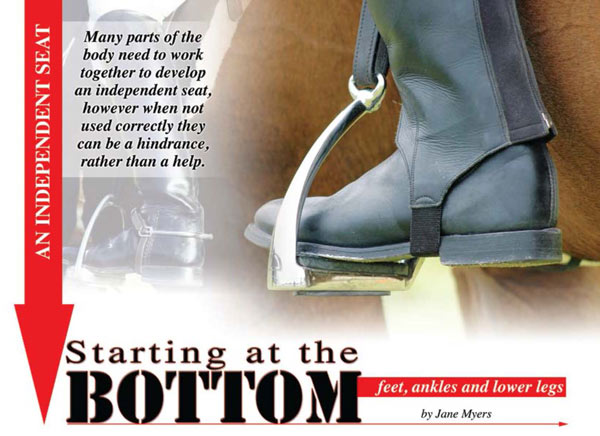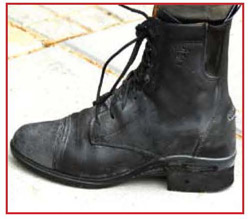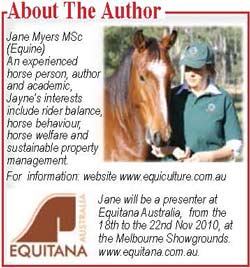|
Vol 31-6 April/May 2010

The key to riders developing a good seat starts - believe it or not - with the feet, ankles and lower legs. The ankles in particular, along with the knees and hips/pelvis, act as shock absorbers and unless they all work properly riders have persistent problems with their stirrups, balance and security. When riders feel insecure they tend to compensate by gripping – which simply makes them even more insecure. By learning how to engage and utilise the shock absorbing joints properly riders can break this vicious circle and move on to bigger and better things – whether that is simply to having more fun or competing at higher levels.
Ankles
Many rider problems are caused by ankles, often because they have been given the wrong information when learning to ride. For example they may have been told to push their heels down, or to wrap their lower leg and feet around the barrel of the horse. Other riders may have past injuries that lead to stiffness in the joints or even looseness in the case of ankle joints (stretched ligaments from ‘going over’ on the ankle when walking or running on uneven ground).
First of all a rider needs to assess the type of ankles they have. Ankles tend to fall into one of three groups. For some, their right and left ankles differ from each other also, which means that they fall into two separate groups. This is usually due to past injuries but sometimes people naturally have one ankle that behaves differently to the other. In each case each ankle needs to be treated differently.
Stiff ankles: Some people are just naturally stiffer in their joints than others and some have stiffness in one or both ankles due to past injuries. People who have naturally stiff ankles will usually have stiffer joints throughout the body in general and tend to be those who either hate yoga because they cannot do it or keep going to yoga thinking that one day they will be able to get their leg behind their head! Yoga will certainly help to make these people more flexible and continuing with this form of exercise is more beneficial than just hoping that one day they will suddenly wake up and be as flexible as a rubber band.
Naturally stiff ankles need a careful stretching program before mounting a horse and a good stretch in particular is to stand with the balls of the feet on the edge of a low step and gently lower the heels. It is important to stop if pain is felt and to hold a prolonged stretch rather than bounce up and down. When the rider mounts they can further warm up by standing in the stirrups and allowing their weight to pass down the legs and into the heels.
If a rider is stiff in one or both ankles due to old injuries it is advisable to see a professional body worker who may recommend specific exercises to help with this - it really is worth the effort and expense as the ankles are crucial to riding.
People with stiff ankles are usually better off wearing short riding boots (that do not restrict the ankle) and half chaps rather than long boots. The elastic sided short riding boots usually work well, at least until they improve the flexibility of their ankles.
Floppy ankles:
The opposite problem, floppy ankles usually belongs to people who have very flexible joints throughout the body. These are the ones who could ‘do the splits’ easily when younger (and some still can when older). The problem with loose joints is that unless the owner of them stays fit and strong through constant exercise these joints are prone to injury - in particular spraining an ankle by ‘going over’ when walking or running on uneven ground. This leads to lengthened ligaments in the ankle, which tend to stay that way (ligaments once stretched do not recover very well). When riding with this particular problem the ankles tend to roll to the outside rather than dip and spring as they should, in the downwards/upwards plane. Added to this, is the problem that many riders have been taught to wrap their lower leg around the horse. In an individual with stiff ankles, even though they try to do this their ankles will simply not bend to the outside allowing the foot to bend to the inside – so usually no harm is done.
An individual with floppy ankles, however, can wrap their lower leg around the horse and this causes pain and instability in the ankle joint. Because many riders think that a ‘no pain no gain’ attitude is the best way to go they tend to just get on with it and accept the pain.
Right: The higher riding boot that laces-up will give support to riders with ‘floppy’ ankles.
The floppy ankle problem becomes more apparent when the rider tries to balance standing in the stirrups. In this case a sharp pain may be felt in the outside of the ankle joint if the ankle is allowed to flex to the outside.
Riders with floppy ankles should initially strap either one or both ankles for riding (depending on whether they are both floppy or only one of them). This can be done with an ankle brace purchased from a chemist. Before going to the trouble of buying an ankle brace though, a leg bandage from a grooming kit wrapped in a figure of eight around the offending ankle and foot on the outside of the rider’s boot may resolve the problem for some. Riders are amazed at how much stability this gives the ankle/s and how comfortable riding becomes when they no longer have to mentally concentrate on keeping the ankle still or are distracted by the pain.
In the longer term, riders with floppy ankles usually benefit from wearing long boots or short boots that lace or zip up around and above the ankle to support it/them. In time the ankle/s may needs less support but from past experience it is easier to loosen a stiff ankle - unless it has been badly injured - than firm up a floppy ankle, because once ligaments etc have stretched they tend to stay that way, so long boots may be a permanent fixture in this case. Great news if riders are just looking for an excuse to have long boots made to measure!
Ideal ankles: 
When an ankle is not too stiff nor too floppy then its an ideal situation. In fact, that can be said about much of the rider’s body, it is about having just the right balance between being too stiff and too floppy - and ankles are no exception.
Ideal ankles allow the rider to ride with the heel just below the toe and are able to dip and spring when required. They lower slightly when weight travels down the leg, such as when the rider is rising to the trot or standing in the stirrups. This means the ankles can do what they are meant to do, act as shock absorbers, dampening the movement of the horse.
When reviewing riding from this new point of view, the first check would be the stirrup length. Many riders ride too long, for example dressage riders who want to look elegant and long in the leg commonly ride longer than they should for balance and effective use of the aids. A rider should be able to raise their seat out of the saddle slightly and at the same time allow the heel to drop slightly. If they have to stand on tip toe to raise their seat out of the saddle then the stirrups are too long and the lower leg will never be engaged properly because once the rider’s heel comes above the toe the lower leg disengages and the rider will become insecure. Try taking the stirrups up one hole to see what a diffence it makes (they can always be put down again).
Signs and remedies for lower legs behaving badly:
Losing the stirrup either partially or fully:
When this occurs it can mean the rider’s ankles are not dipping and springing properly (probably stiff) so they resort to gripping with the knees and therefore raising their centre of gravity. The rider needs to do some standing in the stirrups exercises in walk and trot with a soft knee (no gripping) to engage the lower leg and stretch the calf and Achilles tendon. Also concentrate on simply draping the legs on the horse (like a table cloth drapes on a table) rather than hanging on for grim death.
Top: A gentle stretching program, before mounting, for riders with stiff ankles is to stand with the balls of the feet on the edge of a low step and gently lower the heels.
Centre: Wrap the floppy ankles with either an ankle brace from a Chemist (left) or a leg bandage from the grooming kit (right) on the outside of the boot (photo just shows area to be wrapped).
Right: Gripping with the knee can be the cause of riders losing their stirrup.
Experiencing pain in the outside of the ankle:
In this case the ankle is usually too floppy and needs support from a bandage, ankle support and/or boots that support this part of the anatomy. Then, when riding, the rider needs to concentrate on weighting the inside of the foot more to keep the ankle from flopping outwards. The ankle should only be allowed to move up or down, not side to side. In time this will start to feel ‘normal’ as the brain ‘files’ this new feeling. Do not be tempted to use stirrups that have a tilted bar as this can make the situation worse and lead to more ankle problems in time. The tilted bar simply mirrors the incorrect foot angle rather than helping correct it.
‘Dead’ toes (always the outside toes) when riding:
This is a very common problem and it is usually because the rider is trying to ‘wrap’ their lower legs around the horse and point their toe in, as many have been told to do. Because this is physically impossible for anyone with normal shaped legs, the rider ends up rolling the ankles to the outside. Instead the rider needs to concentrate on weighting the inside of the foot, which will initially feel strange and they may feel like a duck as their body grows accustomed to the position. Eventually, even pressure should be felt across the ball of the foot, not just on the outside. Again, do not be tempted to use tilted stirrup bars, instead concentrate on making the balls of the feet stay parallel with the ground.
It is quite acceptable to ride with the toes pointing to 5 to 1 or even at 10 to 2. Some people are simply built that way and trying to force their feet and ankles into an unnatural position will damage the knees and hips and prevent them from riding well. Once a rider improves the leg position so the leg hangs directly underneath them from the hip, the foot usually naturally turns out less due to the rider’s new hip position.

Top right: The well placed, balanced lower leg allows the rider to engage the horse and be effective with their aid and is the first step towards an independent seat.
Right: When standing in the stirrups the heel should be just below the toe and the weight balanced on the ball of the foot to enable the rider to learn how to engage and utilise the shock absorbing joints properly. Photos by Jane Myers.
Aching feet:
Some people actually curl their feet up when riding, possibly because they feel insecure and innately they are trying to grip with their feet. And, just like a locked jaw results in stiffness far beyond the jaw, stiff feet results in a stiff lower legs, so a concentrated effort is needed to relax and spread the toes out. For some, the reason their feet ache is because they wear orthotics for walking and their riding boots do not give them the same level of support. So experiment with wearing orthotics for riding if this is the case. Keep in mind though, that modern riding boots now often have arch support built in so this may not be necessary.
The stirrup ends up diagonally across the foot:
This is often a habit that comes from the way the rider was taught. The stirrup bar should sit across the foot directly under the ball of the foot, not angled across the foot with the outside further forward than the inside. Some riders deliberately put the stirrup this way on the foot believing this is correct. Practice with the stirrup in the new position- under the ball of the foot - until it feels normal.
For others the stirrup just ends up this way while riding because the rider is not weighting the stirrup correctly.
Lower legs flap:
A lack of engagement of the lower leg causes them to flap and this occurs in both floppy and stiff ankled individuals. Work on standing in the stirrups with a soft knee. If the ankles are stiff the rider needs to concentrate on allowing the heels to gently lower, stretching the calf and Achilles tendon, conversely if the ankles are floppy (after giving them some additional support), the rider needs to work on preventing the heels from dropping all the way down when standing in the stirrups. In all cases the heel should be just a couple of centimetres below the toe for riding on the flat. This then gives room for the heel to dip further when required as shock absorbers need room to move. Regular practice of the standing exercises will engage the lower leg and stabilise it.
A body worker specialist is recommended if any problem is due to injury. When returning to riding after a break it is normal to feel some muscle pain but persistent pain in the joints usually needs expert attention.
Improving the lower legs involves firstly, identifying the problem, then taking the appropriate steps such as wearing boots that allow the ankles to move more freely in the case of stiff ankles, or supporting floppy ankles with strapping and boots. Checking the stirrup length and taking them up if necessary (it usually is!), placing the foot in the stirrups correctly - weighting all of the ball of the foot, not just the outside, then working through balance exercises (standing in the stirrups with a soft knee) to get the ankles working properly in the downwards/upwards plane only – which leads to proper engagement of the lower leg.

|